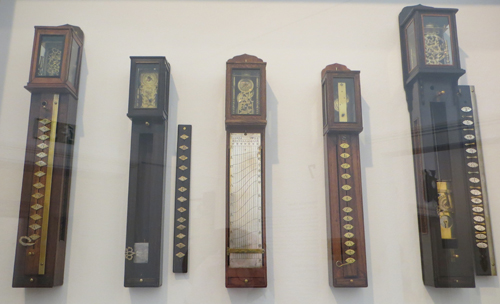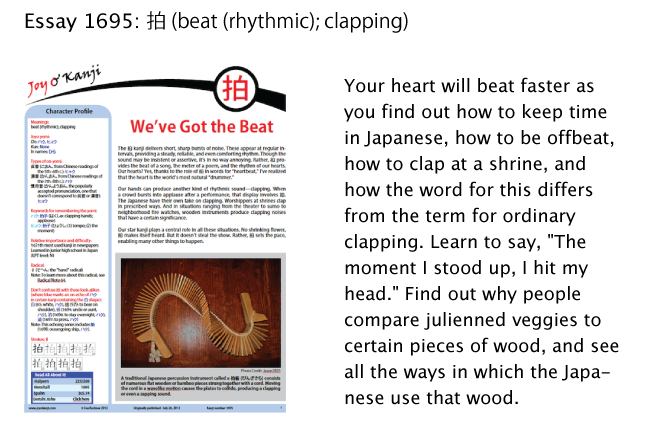Refractions
I live just an hour and a half from Sacramento, and yet I didn't know something fundamental about it until I wrote the just-published essay 1695 on µŗŹ (beat (rhythmic); clapping) and analyzed a photo of a bag of rice:

Photo Credit: Eve Kushner
First we have "naturally abundant":
Ķć¬ńäČ (ŃüŚŃü£Ńéō: nature)
µüĄŃüŠŃéīŃü¤ (ŃéüŃüÉŃüŠŃéīŃü¤: abundant)
Then we find two place names:
Ńé½Ńā¬ŃāĢŃé®Ńā½ŃāŗŃéóÕĘ× (Ńé½Ńā¬ŃāĢŃé®Ńā½ŃāŗŃéóŃüŚŃéģŃüå: the state of California)
ŃéĄŃé»Ńā®ŃāĪŃā│Ńāł (Sacramento, the capital of California)
After that ÕÅÄń®½ (ŃüŚŃéģŃüåŃüŗŃüÅ) means "harvest." The subsequent ŃüĢŃéīŃü¤ turns it into "harvested," an adjective describing ŃüōŃüŚŃü▓ŃüŗŃéŖ, the brand of rice. We therefore have "Koshihikari rice, harvested in Sacramento, California, where it's naturally abundant." Really? I knew Sacramento abounded in politicians, but rice fields???
Yes, one Japanese site says this:
õ╗ŖµŚźŃĆüÕģ©ń▒│õĖĆŃü«ń▒│Ńü®ŃüōŃéŹŃü»ŃéĄŃé»Ńā®ŃāĪŃā│ŃāłĶ┐æķāŖŃü¦ŃüÖŃĆé
Today, the outskirts of Sacramento produce the largest amount of rice in the United States.
õ╗ŖµŚź (ŃüŹŃéćŃüå: today); Õģ©ń▒│õĖĆ (Ńü£ŃéōŃü╣ŃüäŃüäŃüĪ: number 1 in America); ń▒│Ńü®ŃüōŃéŹ (ŃüōŃéüŃü®ŃüōŃéŹ: rice place); Ķ┐æķāŖ (ŃüŹŃéōŃüōŃüå: outskirts)
How wonderful to see ń▒│ used in such different ways here, first as "America" and then as "rice"! It's also mind-blowing that a city known for little more than budget impasses and sweltering summers produces the same thing as Japan.
A Japanese friend who lives near there explains that the cultivation process is actually different from the one in Japan. For one thing, after the fields are prepared, they use crop-dusting planes to plant the rice, then water the fields during the growing season, then dry out the fields for a winter harvest. Practically all the saké produced in California uses rice grown along the Sacramento River, he said.
If it weren't for a Japanese site about Sacramento, I wouldn't know any of this! Perhaps I shouldn't be surprised because this keeps happening. Through the study of kanji, I'm finding out not just about Japan and China but also Africa and ancient Greece! Conversely, in an Austrian museum I recently learned a bit about Japan. Here are a few samples of what I mean.
1. A Window onto Africa
In essay 1650 on ķÖČ (pottery; training; contented, entranced), I wrote about this term:
ķÖČķģö (Ńü©ŃüåŃüÖŃüä: intoxication, fascination, rapture)
entranced + intoxicated with strong emotion, infatuated, fascinated
As I discovered, one can be intoxicated not only by liquor but also by music. For example, I found a blog post with this title:
ŃāĀŃāōŃā®ŃĆüķ¤│µźĮŃü½ķÖČķģöŃüÖŃéŗŃü▓Ńü©Ńü¤ŃüĪ
"People Drunk on the Music of the Mbira"
ķ¤│µźĮ (ŃüŖŃéōŃüīŃüÅ: music); Ńü▓Ńü©Ńü¤ŃüĪ (õ║║ķüö: people)
The blogger describes a conference about the mbira, a traditional African instrument with metal keys. And she raves about how the event moved people:
ķŁéŃüīÕŗĢŃüŗŃüĢŃéīŃéŗ
ķŁé (Ńü¤ŃüŠŃüŚŃüä: soul); ÕŗĢŃüŗŃüĢŃéīŃéŗ (ŃüåŃüöŃüŗŃüĢŃéīŃéŗ: to be moved by, be touched by)
She says that during a ritual in which they used the mbira to call to the spirits of ancestors, the instrument gave off mysterious and beautiful sounds that came one after the other, making a deep impression on people's hearts. They were spellbound (ŃüåŃüŻŃü©ŃéŖŃü©) .
I suppose I could just as easily have learned about the mbira in English, but I think my reading never would have taken me to Africa in quite that way.
2. A Throwback to Ancient Greece
In writing the forthcoming essay 1564 on Ķāå (gallbladder), I learned that the word for "bile" breaks down as "gallbladder juice"!
Ķāåµ▒ü (Ńü¤ŃéōŃüśŃéģŃüå: bile) gallbladder + juice
Yum! If you add Ķ│¬ to this word, you produce something altogether different:
Ķāåµ▒üĶ│¬ (Ńü¤ŃéōŃüśŃéģŃüåŃüŚŃüż: choleric temperament) bile (1st 2 kanji) + temperament
Kotobank defines Ķāåµ▒üĶ│¬ as one of four temperaments that belonged to the theory of "humorism." In that framework, it was thought that an excess of a particular bodily fluid caused certain personality traits to emerge, as follows:
yellow bile (Gk. chole): choleric (ambitious and leaderlike)
black bile (Gk. melan chole): melancholic (analytical and thoughtful)
phlegm (Gk. phlegma): phlegmatic (relaxed and quiet)
blood (Gk. haima): sanguine (pleasure-seeking and sociable)
Wikipedia gives a much fuller picture of these personality types.
The concept of four humors apparently originated in ancient Egypt or Mesopotamia, says Wikipedia. Then the Greek doctor Hippocrates (approx. 460–370 BC) systematized it, advancing the idea that the human body has four fluids and that human health depends on the balance of those fluids. The Roman doctor Galenus took this theory and divided the human character into four temperaments (melancholic, mucilaginous, choleric, and sanguine), each associated with an excess of a fluid. And this schematic held on in Europe for about 2,500 years! In fact, Wikipedia calls it "the most commonly held view of the human body among European physicians until the advent of modern medical research in the nineteenth century."
The idea of the four humors has long been discredited around the world, including in Japan. My proofreader had never heard of Ķāåµ▒üĶ│¬, and he feels that few Japanese know about the theory from which it comes. And yet the idea has left an indelible effect on English.
For instance, the Greek melan chole gave English speakers "melancholy." (From this I have also realized that the Greek melas meant "black," just as it does in "melanin" and "melanoma.")
I didn't know until now that "phlegmatic" could mean anything positive. I thought it was simply "sluggish." But the dictionary confirms that a phlegmatic person tends to be calm and composed.
Meanwhile, "sanguine" means "cheerful," even though it is dripping with blood (i.e., sang in French).
Through kanji I learn not only about ancient Greece but also about my own language!
3. Japanese Clocks in Vienna
In a clock museum in Vienna, I unexpectedly came upon a display of 18th-century Japanese "pillar clocks" or Õ░║µÖéĶ©ł (ŃüŚŃéāŃüÅŃü®ŃüæŃüä):

Photo Credit: Eve Kushner
Drawing closer, I noticed kanji engraved all over the front:

Photo Credit: Eve Kushner
I spotted numbers going down the left: ÕģŁ (6), õ║ö (5), Õøø (4), õ╣Ø (9), Õģ½ (8), õĖā (7), and so on. But how did the order make sense? On the right I recognized zodiacal kanji: ķģē (Ńü©ŃéŖ: rooster), µłī (ŃüäŃü¼: dog), õ║ź (Ńüä, representing ŃüäŃü«ŃüŚŃüŚ: wild boar), ÕŁÉ (ŃüŁ: rat), õĖæ (ŃüåŃüŚ: cow, ox), Õ»ģ (Ńü©Ńéē: tiger), ÕŹ» (Ńüå, representing ŃüåŃüĢŃüÄ: rabbit), ĶŠ░ (Ńü¤Ńüż: dragon), ÕĘ│ (Ńü┐, representing ŃüĖŃü│: snake), ÕŹł (ŃüåŃüŠ: horse), µ£¬ (Ńü▓ŃüżŃüś: sheep), and ńö│ (ŃüĢŃéŗ: monkey). To understand how these zodiacal kanji differ from ordinary animal kanji, see Crazy for Kanji, p. 175.
Still I was entirely lost. Weeks later, my proofreader explained the clock this way: The golden horizontal bar is a weight. Around 6 p.m., people would set it at the top, aligning it with ÕģŁ and ķģē. The bar would slowly drop all day until it reached ÕģŁ and ķģē at the bottom around 6 p.m. Noting that the upper half represented the nighttime whereas the lower half represented the daytime, he interpreted the rows this way:
1st ÕģŁ and ķģē = around 6:00 p.m. (sunset)
1st õ║ö and µłī = around 8:00 p.m.
1st Õøø and õ║ź = around 10:00 p.m.
1st õ╣Ø and ÕŁÉ = around midnight
1st Õģ½ and õĖæ = around 2:00 a.m.
1st õĖā and Õ»ģ = around 4:00 a.m.
2nd ÕģŁ and ÕŹ» = around 6:00 a.m. (sunrise)
2nd õ║ö and ĶŠ░ = around 8:00 a.m.
2nd Õøø and ÕĘ│ = around 10:00 a.m.
2nd õ╣Ø and ÕŹł = around noon
2nd Õģ½ and µ£¬ = around 2:00 p.m.
2nd õĖā and ńö│ = around 4:00 p.m.
3rd ÕģŁ and ķģē = around 6:00 p.m. (sunset the next day)
In the past, the Japanese used the numbers on the left to refer to times of day, he said, reading them this way: ÕģŁŃüż (ŃéĆŃüż), õ║öŃüż (ŃüäŃüżŃüż), ÕøøŃüż (ŃéłŃüż), õ╣ØŃüż (ŃüōŃüōŃü«Ńüż), Õģ½Ńüż (ŃéäŃüż), and õĖāŃüż (Ńü¬Ńü¬Ńüż). None of the yomi include the small ŃüŻ, as they're archaic.
Above the vertical lines are the names of the months, going from winter to summer as you move from left to right.
The intervals between the wavy lines indicate about two hours, but as you can see, the intervals shrink or expand, depending on the season. That is, on the upper left, you find long winter nights. And on the lower right, summer days are long.
To tell the time, you would find the place where the golden bar, the vertical line (month), and the wavy line met.
How much more there always is to discover—and in the least expected places! In order to learn more about Iceland, for instance, perhaps I should travel to Bali!
Here's a preview of the new essay 1695 on µŗŹ (beat (rhythmic); clapping):

Have a great weekend!

Comments